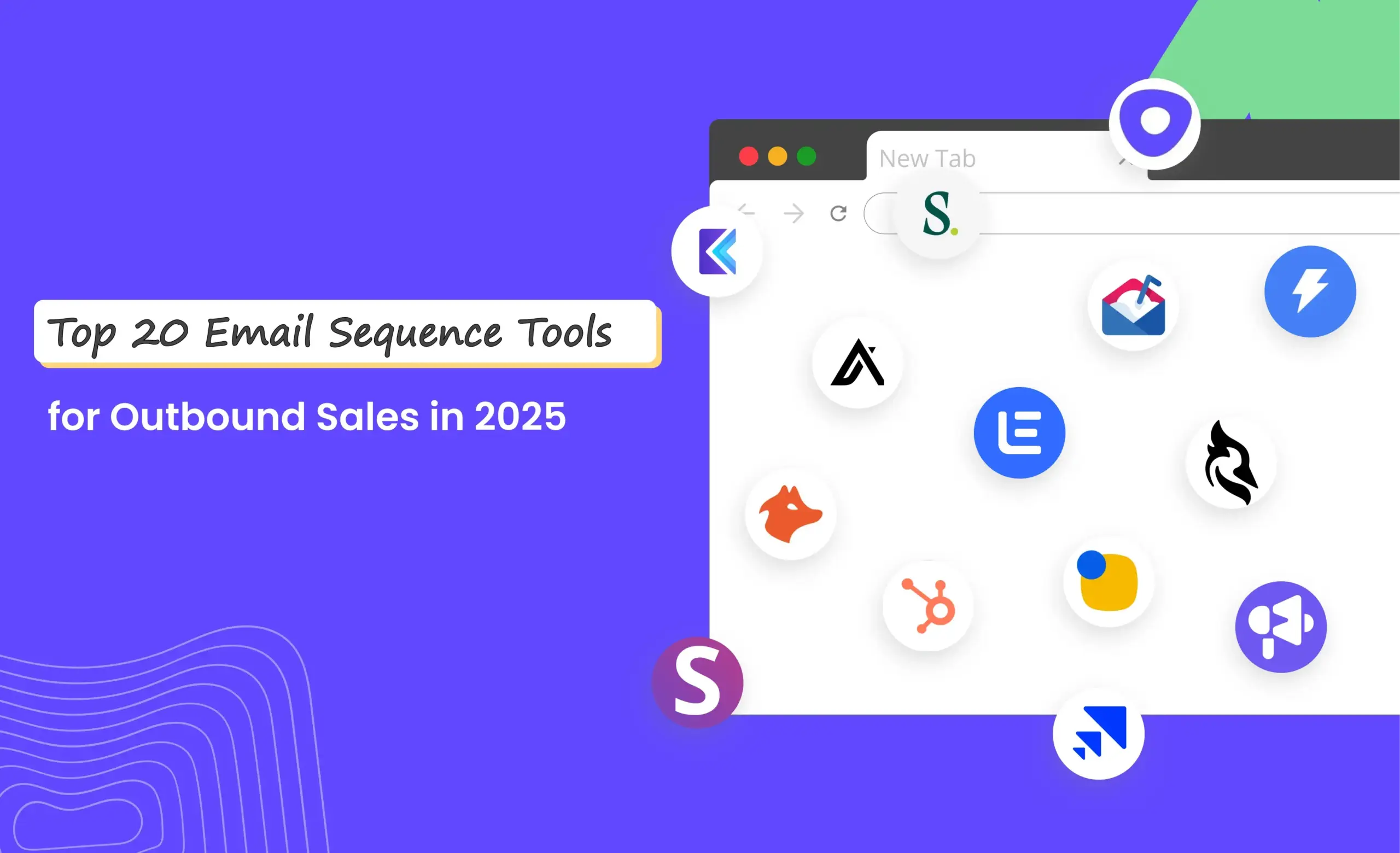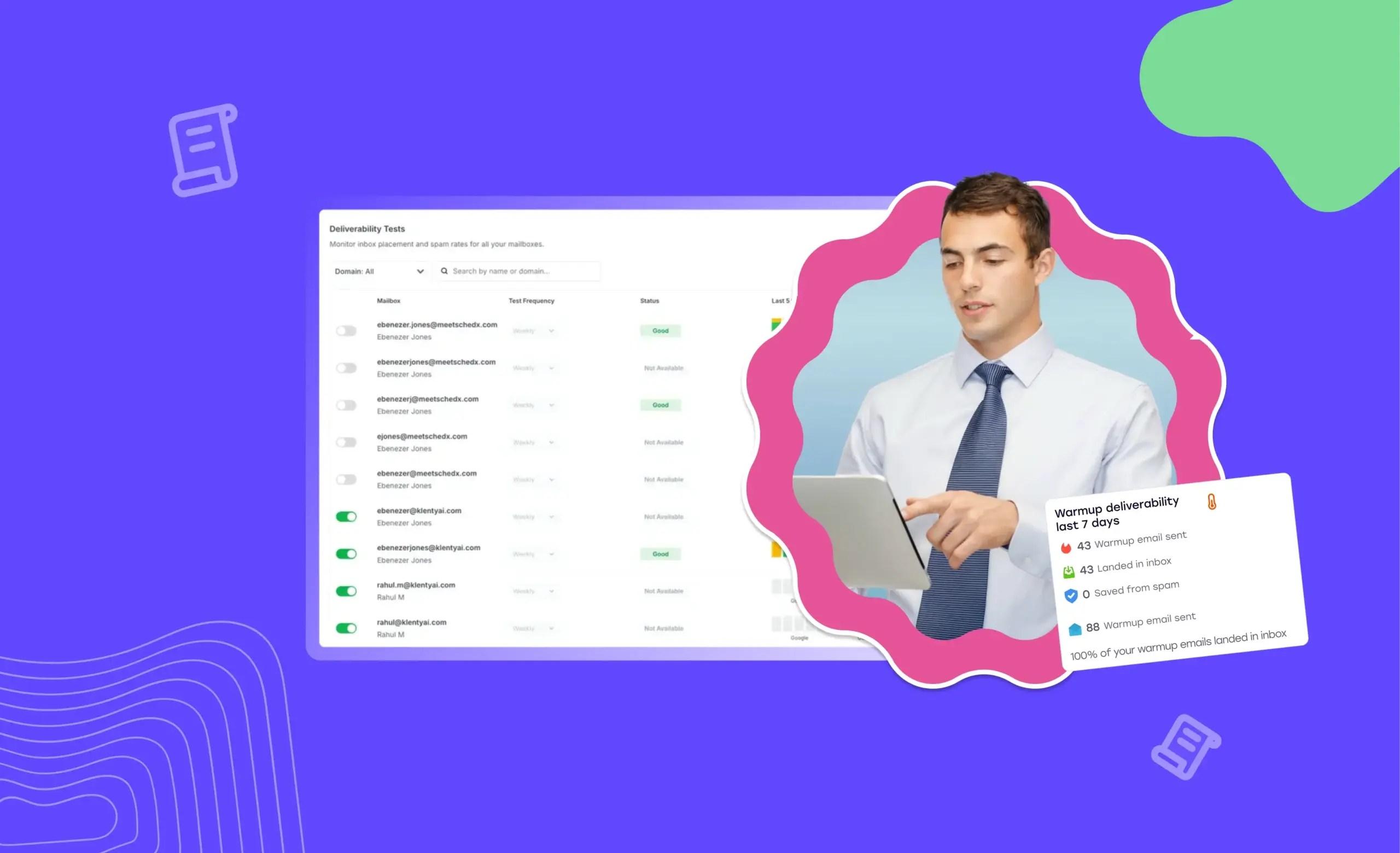The dreaded spam filter is every sales rep’s bane of existence.
Email spam filters determine if your email lands in your prospect's inbox or gets banished to the deserted spam folder.
And with emails rapidly becoming a popular form of digital communication, email spam filters have become more sophisticated than ever. And rightfully so, they protect users from cyber threats and attacks.
So how do you dodge these filters and land in the prospect’s inbox?
Think of spam filters as gatekeepers of a building you are trying to access. Become friends with the gatekeepers, learn what makes them happy, and you will enjoy easy access.
In this blog, you will learn how to avoid spam filters and enjoy easy access to your prospect's inbox.
What Is a Spam Filter?
Spam filters intercept spam emails, preventing them from reaching the intended recipient's inbox.
They analyze different elements of your email, such as its content, sender information, and formatting, to determine if it is legitimate or spam. How?
By using a combination of different patterns and algorithms to assign scores to different characteristics of an email. If the score exceeds the benchmark, the email is flagged as spam and sent to your email provider's junk folder.
How Do Email Spam Filters Work?
Email Service Providers (ESPs) like Gmail, Outlook, Yahoo, etc., place filters in their systems in an effort to protect their users from unsolicited emails.
Also known as email spam filters, these filters are basically algorithms such as Naïve Bayes, Bayesian algorithms, transformers, etc., that review incoming mail to prevent junk from reaching a user’s inbox. They use a rating system to judge if a mail is worth delivering to the primary inbox.
Spam filters weigh several parameters like:
- Sender reputation: Your sender reputation is your email rating. It is based on your domain authority and the size and quality of your email campaigns. A good sender reputation is one of the best ways to avoid the spam filter.
- The volume of emails sent: The number of your emails also affects where they land, especially when you're shooting them to multiple prospects at once. So, instead of sending emails in bulk, send them in batches. This signals the ESP that you're sending legitimate emails, improving your email deliverability.
- Email engagement rate: Your email engagement rate is how your recipients interact with your emails. A good user engagement rate helps you avoid the spam filter. This is because it indicates your emails are not only making it to your prospects' inboxes but also capturing their attention. On the flip side, a low user engagement rate affects your sender reputation negatively.
Spam filters assign a spam score. Based on this, they decide whether to pass an email through the filter and land it in the inbox. Since there are different approaches to catching spam traps and each filter has unique criteria to judge an email, it can be difficult to avoid spam filters.
Don't worry. We’ll show you how to circumvent these spam filters and land in your prospect's primary inbox.
Avoid the Spam Filters With These 9 Steps
Just like how Rome wasn’t built in a day, you shouldn’t start sending your email campaigns from day 1. You have to set things in motion for your domain and email in order to start sending cold emails at scale and get higher open rates.
Otherwise, the sudden and large volume of activity with your email account signals the ESP of suspicious activity. If this happens, your email address stands the chance of ending up on the blacklist.
So, here’s how to avoid spam filters when sending emails.
1. Configure Your Technical Settings
Start by building a good domain reputation. Spam filters use your domain reputation to determine whether your emails land in the primary inbox or the spam folder.
Your domain reputation depends on the following factors:
- Spam rate: The percentage of emails sent from a particular domain that were filtered out and landed in the spam folder directly.
- Bounce rate: This refers to the percentage of emails sent from a domain that was rejected by the prospect’s email server and returned to the sender.
- Spam report: If a prospect particularly marks you as spam, it is considered a spam report. Spam reports are the last thing you’d want as an email sender—they immediately set off spam filters and severely affect your email deliverability. Regularly tracking these metrics and keeping them minimal is the best way to build your domain reputation.
Next, authenticate the domain that you will use to send the emails.
Domain Authentication is a technical standard that helps the email recipient’s server confirm your identity. In simple words, it verifies that it’s really you who’s sending the email. This significantly reduces your chances of being marked as spam.
How do you authenticate your domain? By setting up three protocols:
a. Sender Policy Framework (SPF): This standard validates your identity by checking if your mail is sent from an authorized IP address of a particular domain.
b. Domain Keys Identified Mail (DKIM): This email authentication protocol affixes a digital signature to every outgoing email from a particular domain name, which is then verified by the prospect’s system. Meeting this standard ensures that an email is not tampered with during transmission.
c. Message Authentication, Reporting, and Conformance (DMARC): DMARC policies verify if the sender’s domain is authenticated with SPF and DKIM protocols and provide information on what can be done if the sender is not verified (such as sending to the spam folder, rejecting the mail, etc.). Contact your IT team to check if your SPF and DKIM are set properly.
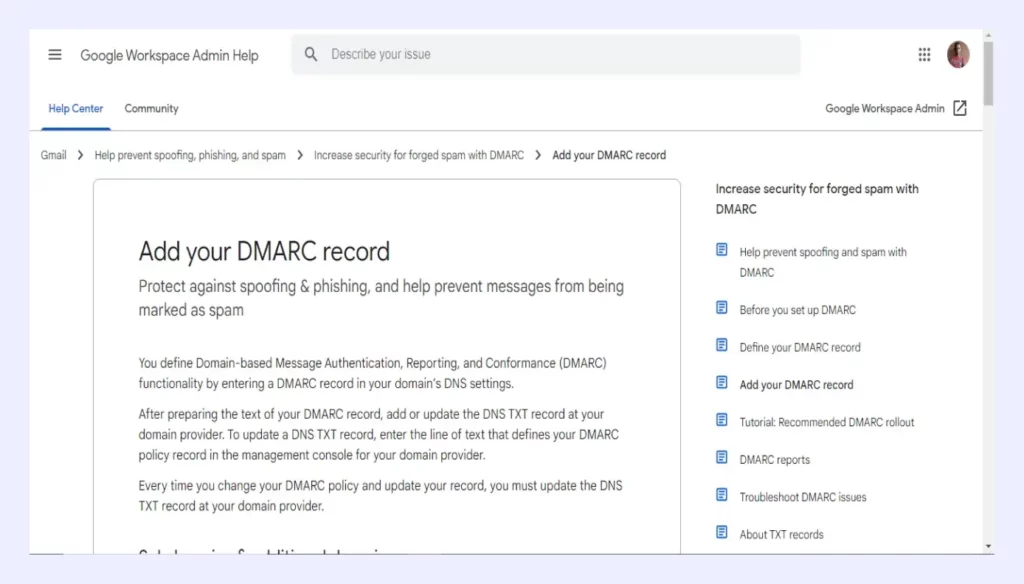
Source: Google Workspace
Finally, set up your IP address.
An IP address is a number registered in your domain that is authorized to send emails/messages on behalf of the domain. Use a reliable IP address to send emails.
Every IP address has a rating and if it is low, your emails will likely be considered spam and might be at risk of not being delivered. That is why it’s crucial to maintain a good IP reputation. Use tools like Sender Score by Validity or Barracuda Central to check if your domain or IP’s reputation is moving up or down over a period of time. If you see your reputation going downhill, it might be time to reduce the email volume.
2. Monitor the Engagement Metrics
Engagement metrics like reply rate, click rate, etc. indicate your prospects’ interest in your emails.
When a prospect positively engages with your mail by replying to it or downloading a resource, it signals the spam checker that you’re a legitimate sender. This, in turn, shoots up your email reputation.
You can increase your engagement rate by only contacting prospects who have a real need for your product and are likely to benefit from it. This will improve their chances of replying to your email and boost your engagement rate. The best way to target the right prospects is to first build an Ideal Customer Profile (ICP) for your product/service. You can do this by listing your top customers and identifying shared attributes.
Then, constantly monitor and review your bounce rate to keep it at a minimum.
Tracking bounce rate helps you evaluate the risk of being blacklisted by spam filters.
An email is considered bounced when it is not delivered for permanent reasons such as fake email addresses or your prospect’s domain not being verified. This is something you’d want to avoid.
The more bounces you get, the more your reputation suffers and the more difficult it is to avoid spam filters. It is a vicious cycle that is tough to get out of and your email deliverability will suffer for a long time.
Also, review your bounces regularly. The best way to minimize bounces? Keep your mailing list fresh, regularly cleaned, and verified from time to time. A “clean” email list has a bounce rate of less than 1%.
Anything above that will alert the spam email filters that you’re sending emails to stale email addresses. You can also take the help of email validation services like Klenty or Hunter to validate your email addresses and track your future emails.
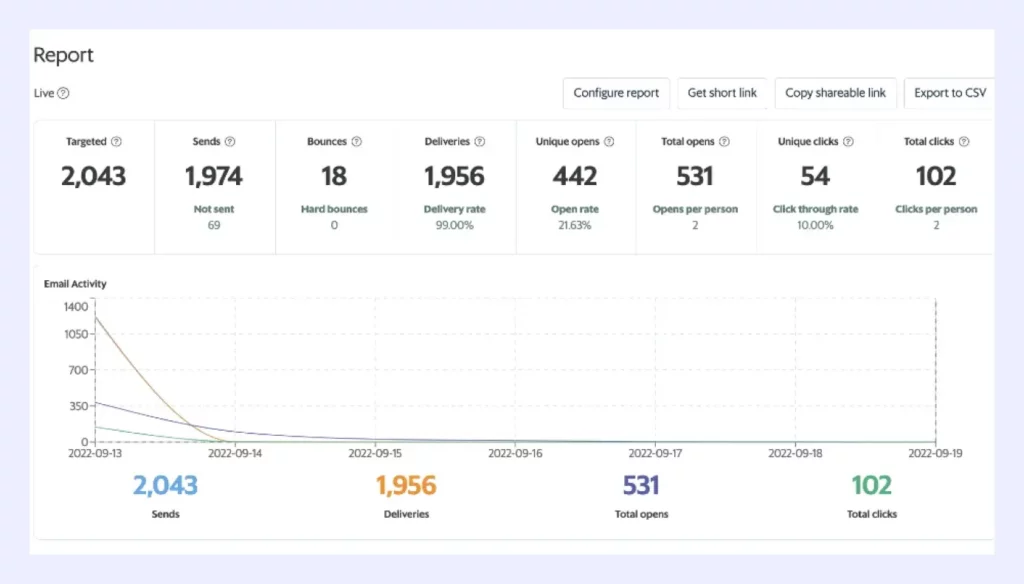
Source: Feathr
3. Personalize Your Emails
Personalizing your emails tells your prospects that you know who they are. It shows them that you’ve put some effort into messaging them. This makes your prospects receptive to your emails and increases the chances of engaging with them, which will improve your engagement metrics.
Your recipient’s ESPs are also constantly tracking your email activity–if you repeatedly keep sending the same email copy, you might alert the spam filters. So, switch between different cold email templates and try experimenting with the different components of your email like:
- The subject lines,
- The email body copy,
- The call-to-action,
- Or even the email signature.
A/B testing these components will help you understand which email template can help you avoid spam, and you can tweak your strategy accordingly. With Klenty, you can set up multiple A/B testing options that will help you pick subject lines that record the most opens, email copies that push prospects to reply, and CTAs that drive action.
4. Follow Spam Laws
Different countries and regions have different spam laws to protect the interest of their citizens. Understanding and complying with the laws will limit the number of complaints against your domain, ensuring your emails land where you want them to–in the inbox. Make sure your emails comply with the standards set by the CAN-SPAM act, such as:
- Provide a physical mailing address.
- Don’t use any deceptive subject lines.
- Honor opt-out requests promptly.
- Accurately identify the person you’re messaging.
Following anti-spam laws also include making it easy for your prospects to unsubscribe.
Provide unsubscribe links at the top or bottom of your commercial emails, so if your prospect is not interested in hearing from you, they can quickly and painlessly opt out–without having to mark you as spam. If your prospect chooses to opt-out, make it frictionless. Don’t ask them to re-enter their email address or username or pass additional hoops–it shows that you respect their preferences. Adding a compulsory opt-out isn’t just a deliverability factor—it’s also required by the cold emailing rules in different countries.
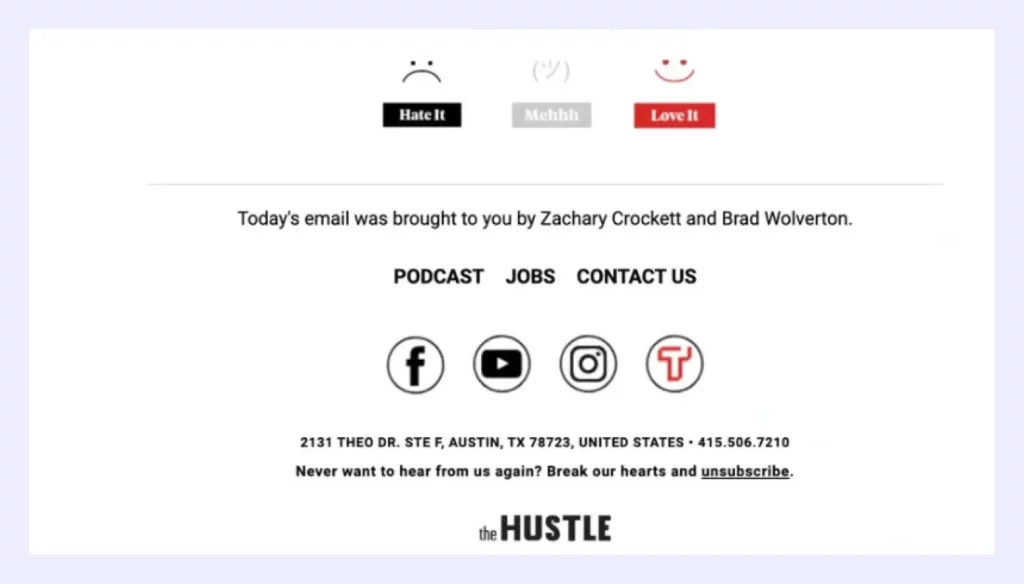
Source: HubSpot
5. Avoid Spam Triggering Words
If it sounds too good to be true, it’s probably spammy email. Words that trigger spam filters such as ‘Free’, ‘Order Now’, ‘Make $$$’, or multiple exclamation points, strange formatting, and different colors are all big red flags. Email spam filters words that contain unnecessary capital letters, any color other than black and blue, and too many punctuations that convey you're desperately trying to get attention, just like spammers.
In a snapshot, if your email is
- Manipulative,
- Cheap,
- Talks about fantasy land,
- Unethical,
They’re going to land in spam. The fix? Avoid email spam trigger words.
How? Put your email copy through a spam trigger word checker such as Mail Tester to check if your template has spammy words that can decrease your chances of deliverability.
Here are some common spam words you should start avoiding:
- Symbols and numerical: 0%, 0% risk, 99%, #1, $$$, 100% free, 100% satisfied, 50% off, !!!!!.
- About Money & Promotions: Affordable deal, Amazing stuff, At no cost, Amazing offer, Avoid bankruptcy, Best price, Billion dollars, Bonus, Certified, Claim your discount, Deal, Explode your business, Free, Free access, Free bonus, Great deal, Congratulations.
- Exclusive offers: Limited time, Get it now, Once in a lifetime, For new customers only, Offer expires, Deal ending soon, You are a winner!, etc. are some spam trigger words to avoid.
- Telling instead of showing: Avoid using phrases like “The best” or “Fantastic” without explaining why something is the best or fantastic in your email subject lines to avoid spam.
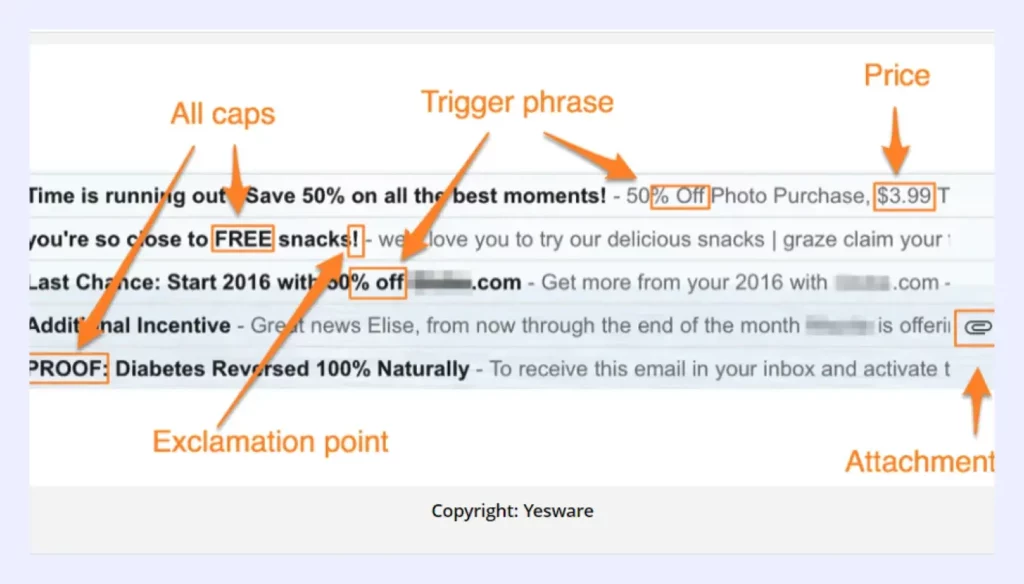
Source: Buzz Fixer
6. Do Not Send Your Cold Emails in Bulk
Spacing out the time period between individual emails, instead of blasting them all in one go, helps improve email deliverability. If you are using an outbound sales automation software to send mail merges or cadences, set it up to have a reasonable interval between emails.
For example, at Klenty, we use a random interval of approximately 2 minutes between each email sent by you. Sending 100 emails in a minute is a signal to the email service provider that you may be a bulk emailer.
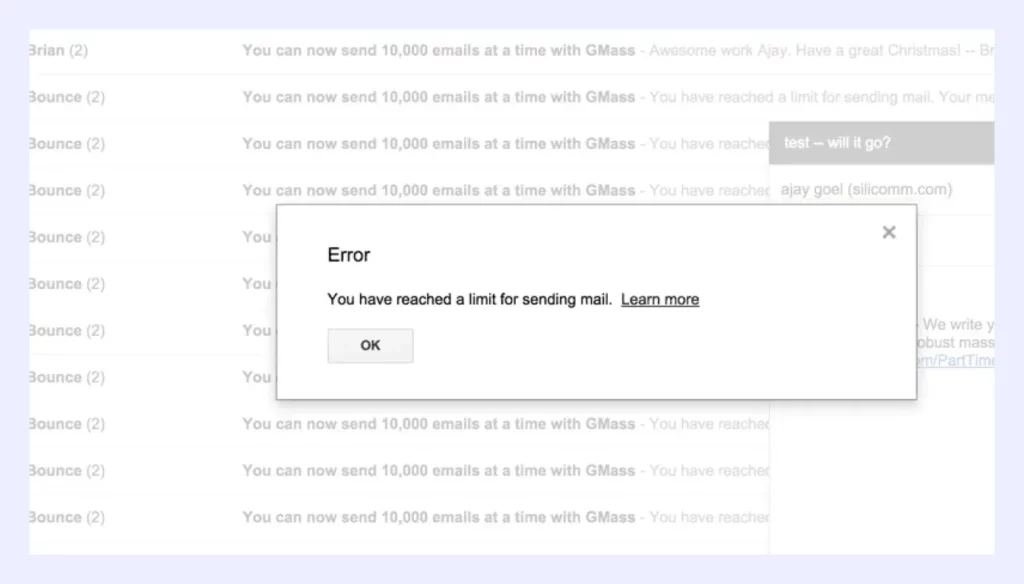
Source: GMass
7. Use Open Tracking Sparingly
It is recommended to limit the number of links added to your email copy as they tend to have a negative impact if your prospect has advanced content filters. For the really sophisticated prospects, you may even want to turn off email open tracking as it could trigger their spam filters.
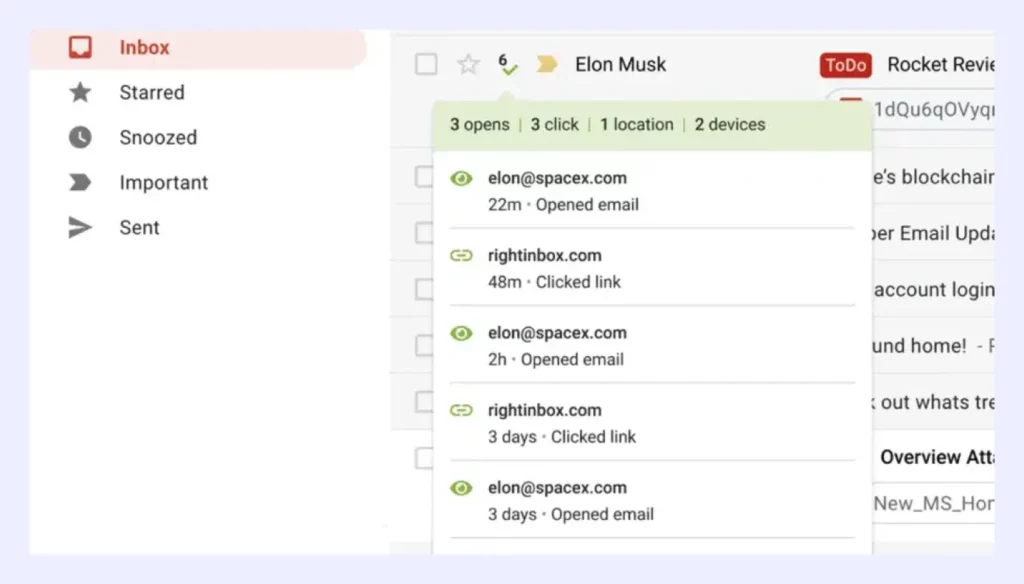
Source: Mailmonitor
8. Do Not Follow-up Aggressively
No denying. Follow-up emails are extremely important to stay on top of your prospects’ minds. But if you’re aggressively following up with too many emails in a short span of time, you’re likely to irritate prospects, and they might even end up reporting you spam–the last thing you’d want as a mail sender.
Maintain a reasonable time gap between each of your follow-ups. Structure your cadence in such a way that your follow-ups provide value to your prospects while not being too frequent.
Pro Tip: On sending break-up emails in her sequences, top-performing SDR manager, Ashley Dees, told us that she doesn’t send them. She adds that prospects who did not respond to the sequences get added to a nurture sequence filled with useful bits of information that is helpful to the prospect, kind of like a newsletter. Give it a try and let us know if it works.
9. Avoid Too Many Attachments and Images
A lot of spammers are known for their spammy attachments. Hence, there’s a high chance that email service could mark your email as spam if it notices heavy email attachments.
That’s why attachments have a negative impact on deliverability. It would be a good idea to hold off on sending attachments unless you really need to. But we understand the need for attachments, in a bid to keep your cold emails short and sweet, we might need to send large bits of information via email attachments. So, if it’s absolutely required, then upload to a cloud storage service like Google or Dropbox, and send the link over.
The image to text ratio in your mail also plays a salient role in avoiding spam filters. Spam filters block any email that doesn’t maintain a healthy balance of text and images.
So, as a general guideline, it is recommended to maintain a ratio of 80% text to 20% images and use alt-text with the images in your email marketing campaigns if you have to use images. We know how important it is to break the pattern of your recipient’s email reading experience. An image that is relevant to their pain point or work would do wonders to your reply rates, but maintain the 80-20 rule when doing so to avoid upsetting the spam gods.
Here is an example of what your email should not look like:
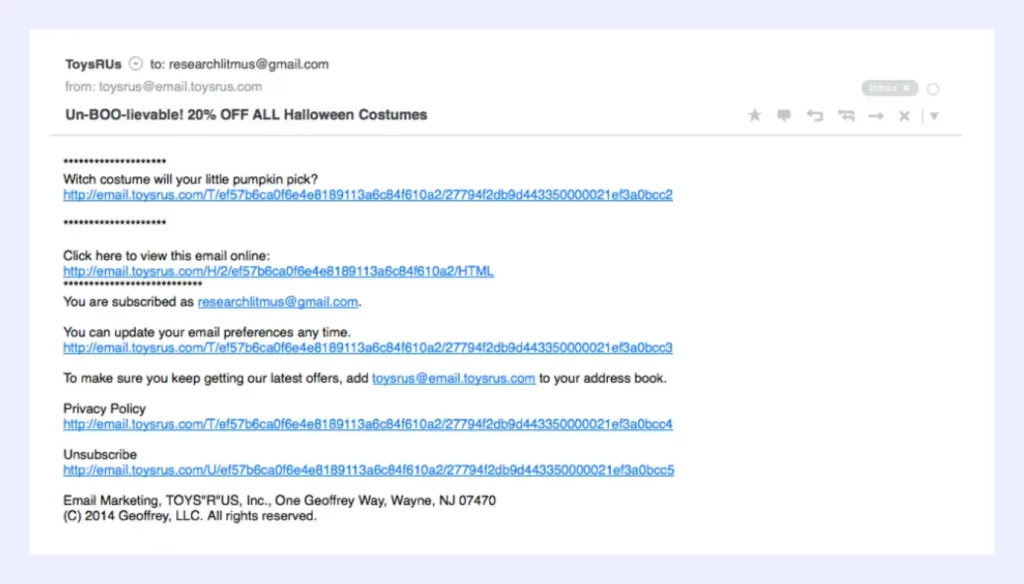
Source: Intelligent Contacts
It All Boils Down to This: Stay on the Right Side
Avoiding the spam filter is not a hard nut to crack. By following best practices, you can carry out your outreaches without an iota of worry about the junk email folder. At Klenty, we take this further and help you avoid the spam filter by:
- checking and validating the list of email addresses involved in your cold outreach
- helping you track your domain and keeping the domain reputation high
- Ensuring you send the right amount of emails per day and not exceed the optimum
- Customizing the unsubscribe link to suit your brand
Spam filters do serve a great purpose. Life will indeed be harder without them. But given the sheer volume of emails they need to classify, they’re just not fair all the time. They do filter out important emails once in a while. The only way to consistently get past them is always to do the right thing.
Difficult? Maybe. But doable. Target the right prospects. Comply with the spam law guidelines. Send personalized emails. Avoid spam trigger words. Craft a professional-looking mail. It’s all about getting the basics right. As long as you get them right, you’re good to go. And we hope this article gets you there.
FAQs
How Do I Stop Getting Sent to the Spam Folder?
- Configuring your technical settings
- Monitoring the engagement metrics
- Email personalisation
- Following spam laws
- Avoiding spam triggering words
- Not sending your cold emails in bulk
- Using open tracking sparingly
- Not following up aggressively
- Avoiding too many attachments and images
What Causes Emails To Go to the Spam Folder?
- Poor domain reputation
- Bad configuration settings
- Use of email spam trigger words
- Sending generic emails in bulk
- Subscribers reporting your emails as spam
Always follow email best practices to avoid the spam folder and increase your email deliverability rate.
How Do I Know if My Emails Are Going to Spam?
How Do I Make Sure My Email Doesn’t Go to Spam in Gmail?
- Only sending emails to people who want to get messages from you.
- Making it easy to subscribe and unsubscribe.
- Setting up SPF, DKIM, ARC, and DMARC.
- Abiding by Gmail’s message formatting guidelines.
- Not sending emails in bursts.
- Ensure you attach visible links in your messages so it is easy to understand

